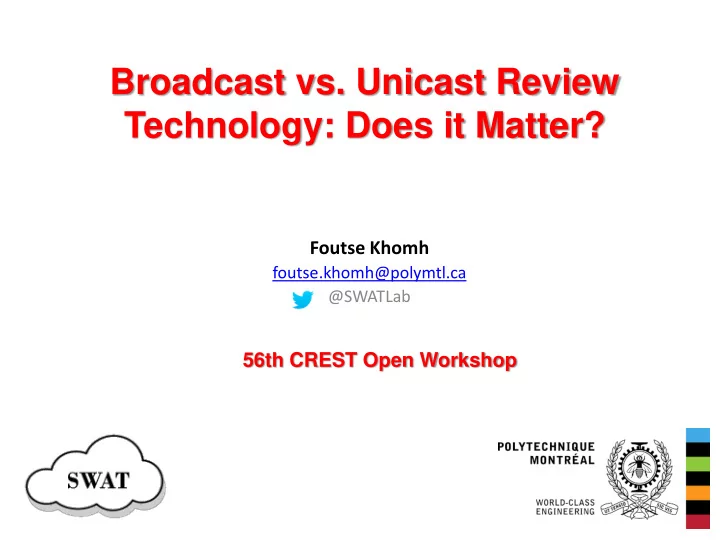

Broadcast vs. Unicast Review Technology: Does it Matter? Foutse Khomh foutse.khomh@polymtl.ca @SWATLab 56th CREST Open Workshop
Code review: What is in that name? 2
Code review: Why? “Expectations, Outcomes, and Challenges of Modern Code Review” Alberto Bacchelli and Christian Bird - ICSE 2013 3
Code review: Common outcomes … “Expectations, Outcomes, and Challenges of Modern Code Review” Alberto Bacchelli and Christian Bird - ICSE 2013 4
Code review: Different types … Over-the-Shoulder Tool-Assisted The Email Thread Pair Programming 5
Code review: Different types … Over-the-Shoulder Tool-Assisted The Email Thread Unicast broadcast Pair Programming 6
Work-flow and Status in Broadcast Environment 7
Work-flow and Status in Unicast Environment 8
Does the Medium Technology Used for Code Reviews Affects Reviews Activities Effort Effectiveness Efficiency 9
Apache Pig 10
Apache Pig Five Apache projects that transitioned from Broadcast to Unicast technology 11
Identification of the transition period 12
Identification of the transition period 13
Research Questions • RQ1: Is review effort related to the review medium used? • RQ2: Is the effectiveness of a patch reviewing process related to the medium used? • RQ3: Is the efficiency of a patch review process related to the medium used? 14
Data Extraction 15
Number of developers involved in a review (NV) Number of rounds necessary to review a patch (NR) Number of review requests for a patch (RQu) 16
Approach • H0 : There is no significant difference between the value of metric m for patches reviewed on broadcasts and those reviewed on unicast Mann-Whitney U test Cliff’s Delta effect Size 17
Findings Number of rounds Number of developers Number of requests P-values Cliff’s d P-values Cliff’s d P-values Cliff’s d 0.843 Negligible 0.016 Large 0.012 Large 0.891 Negligible 0.021 Large 0.017 Large 0.902 Negligible 0.011 Large 0.031 Large 0.931 Negligible 0.017 Large 0.021 Large 0.915 Negligible 0.013 Large 0.019 Large 18
Findings Number of rounds Number of developers Number of requests P-values Cliff’s d P-values Cliff’s d P-values Cliff’s d 0.843 Negligible 0.016 Large 0.012 Large 0.891 Negligible 0.021 Large 0.017 Large 0.902 Negligible 0.011 Large 0.031 Large 0.931 Negligible 0.017 Large 0.021 Large 0.915 Negligible 0.013 Large 0.019 Large More iterations and more requests on Unicast 19
Findings 20
Findings 21
YES Patches reviewed on unicast undergo more iterations, and Unicast’s reviewers are more active during code review. 22
Post review bugs Median review rate (MRR) 23
Approach • H0 : There is no significant difference between the value of metric m for patches reviewed on broadcasts and those reviewed on unicast Mann-Whitney U test Cliff’s Delta effect Size The SZZ Algorithm to link bugs with reviewed patches 24
Approach • SZZ Algorithm 25
Findings Median review rate Post review bugs P-values Cliff’s d P-values Cliff’s d 0.015 Medium 0.021 Large 0.039 Medium 0.017 Large 0.031 Medium 0.014 Large 0.017 Medium 0.011 Large 0.008 Medium 0.031 Large 26
Findings Median review rate Post review bugs P-values Cliff’s d P-values Cliff’s d 0.015 Medium 0.021 Large 0.039 Medium 0.017 Large 0.031 Medium 0.014 Large 0.017 Medium 0.011 Large 0.008 Medium 0.031 Large Fewer post review bugs on Unicast and more review activities 27
Findings 28
Findings 29
Reviews performed on unicast technology are more effective in terms of catching. 30
RQ3: Is the efficiency of a patch review process related to the medium used? Review length (in days) (RL) Response delay (RD) 31
Approach • H0 : There is no significant difference between the value of metric m for patches reviewed on broadcasts and those reviewed on unicast Mann-Whitney U test Cliff’s Delta effect Size 32
Findings Response delay Review length P-values Cliff’s d P-values Cliff’s d 0.015 Large 0.019 Large 0.013 Large 0.016 Large 0.021 Large 0.011 Large 0.015 Large 0.012 Large 0.017 Large 0.022 Large 33
Findings Response delay Review length P-values Cliff’s d P-values Cliff’s d 0.015 Large 0.019 Large 0.013 Large 0.016 Large 0.021 Large 0.011 Large 0.015 Large 0.012 Large 0.017 Large 0.022 Large The review length and the response delay is shorter on broadcast 34
Findings 35
Size of the patches 36
RQ3: Is the efficiency of a patch review process related to the medium used? Broadcast has a short response delay and a shorter review length. 37
Survey of Developers 20 participants 38
Survey of Developers • Q: What motivated the switch from broadcast to unicast? • A: The broadcast is good for discussion (functional/design/release etc.). • A: Unicast technology makes it easier to review patches, track progress on bugs/issues, look up details on old issues , easier to make release notes on what has been fixed, and easier to organize releases. 39
Survey of Developers • “ New developers learn about the code structure faster with broadcast than using unicast.” • “The traffic of patches circulating on broadcast is high , because it circulates among all those who are subscribed to the broadcast medium.” 40
Limitations • SZZ heuristic • The time window sizes • 5 Subject Systems 41
42
More details are available in the paper here: http://swat.polymtl.ca/~foutsekh/docs/ICST-Tita.pdf 43
Recommend
More recommend